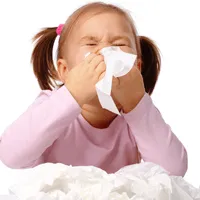Q: Leaves are gone, there are no flowers, but my allergies just keep going. What is it that gets me sneezing and congested during the winter? – Penelope P., Zanesville, Ohio

A: Mold spores and dust mites are the usual suspects when it comes to identifying winter allergies. Mold spores can lurk in piles of rotting autumn leaves; in soil (outside or in house plants); behind the walls of your house – if there’s a slow drip in a pipe; and anywhere that moisture accumulates, from shower stalls to drain pipes (also inside or out). Outdoors, molds can survive the first hard frost. Indoors, they love humidity. Keep yours at 35 percent to 45 percent, or you’re just asking mold to thrive.
Then, there are dust mites. These microscopic critters live indoors and feast on dry flakes of human skin that collect in bedding, mattresses, upholstered furniture, bookshelves, behind radiators and in closets. They crank out little bits of waste (mite poop, really) and that’s what triggers your allergy. The best defense? Wash bedding in water that’s 130 F or higher, get mite-proof bed coverings and keep inside humidity below 35 percent.

But we like the idea of making an end run on allergies by boosting your immune system and desensitizing your body to the allergy triggers. What works? Some studies show that getting a lot of folate from food (fortified grains, spinach, asparagus and broccoli) and 400 micrograms from a supplement can reduce symptoms by 31 percent and wheezing by 40 percent. Also, go easy on the alcohol: Two drinks a day makes you more likely to have year-round allergies. And cutting down may reduce your symptoms. It’s worth a try!
– Dr. Michael Roizen & Dr. Mehmet Oz
© 2012 Michael Roizen, M.D. and Mehmet Oz, M.D. Distributed by King Features Syndicate, Inc.

